| 1 | Part of the “big 4” of Indian snakes |
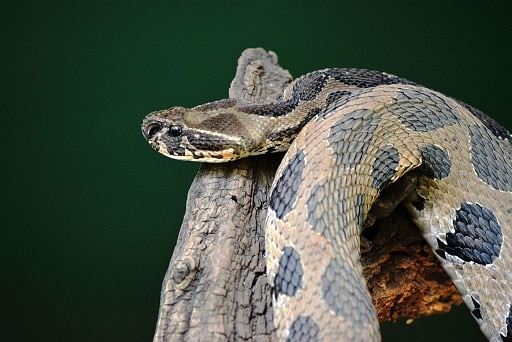
Roughly 70% of fatal snakebites happen in Asia, and of those, India is the undisputed capital. India has 52 venomous snakes in total, and 54,000 Indians perish to snakebite each year, whether within hours or two to four drawn-out weeks.
4 species are elevated above the rest in terms of deadliness: the common krait, Indian saw-scaled viper, Indian cobra, and last but not least, the Russell’s viper (Vipera russelli). This snake isn’t necessarily the deadliest per bite, but because it lives in close proximity to human settlements, it kills by far the most people.
It’s said that the Russell’s viper causes 43% of snakebites in India, and 20-30% in Sri Lanka. The figure for Burma is 70-80%. The Russell’s viper is so unstoppable in its natural habitat that other snake species are mimicking its colours, particularly the rough-scaled sand boa. The Russell’s viper even brings the intimidation factor, as it’s rumoured (though not confirmed) to have the loudest hiss of any living snake.
This snake is so feared in India that several myths have sprung up. One states that its mere hiss will cause your body to start rotting, as you look down in horror. Another says that its foul breath can cause leprosy.
| 2 | Where to find them |
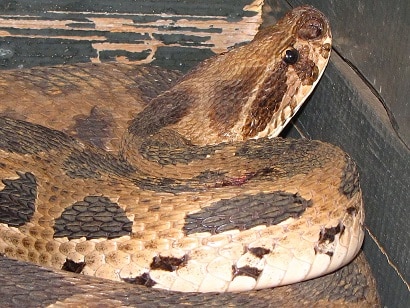
The Russell’s viper is a moderate length, averaging at 120-160cm. Its patterns are circular, occasionally joining together to form zig-zags. Their patterns are dark grey, but the underlying scales vary in colour. They’re usually grey with faint green tinges, but can occasionally be yellow.
The exact colour depends on the individual snake’s habitat. Russell’s vipers mainly live in wide, open spaces, and are naturally averse to dense forests. Their favourites include open grasslands, scrublands, agricultural fields, and sparser forests. They also dislike overly moist environments, such as swamps or marshes.
Russell’s vipers are rarely found at high altitude, but occasionally climb to 2000 metres in the Himalayan foothills. They inhabit almost all of India (and the whole of Nepal), with the exceptions of the far north and high mountains. On their eastern borders, they spill into Burma and Bangladesh, while their western frontiers cross into eastern Pakistan. Sri Lanka is also a primetime hub for these vicious snakes.
| 3 | They makes farmers’ lives a living hell |
The Russell’s viper has one twist of fate that makes it particularly dangerous: its overwhelming dietary preference for rodents. This causes them to stray very close to human settlements, particularly the old barns and huts of farmyards. In parts of rural India, where roads are poor and the countryside is teeming with wildlife, Russell’s vipers are a constant terror for farm workers. They’re an everpresent threat, so that many villagers fear even entering the shadowy rows of crops. Indian farms are very different to an ultra-profession German wheat field: they’re much bushier and overgrown.
Many workers also lack basic defences, such as tough, leathery boots. Another factor is that Russell’s vipers are an ambush snake, and are extremely sluggish even compared to other ambush snakes. They edge forward imperceptibly through the grass, which combines with their grey-tinged camouflage to make spotting them incredibly difficult.
In Sri Lanka, Russell’s vipers are abundant in rice paddy fields, semi-aquatic fields which regularly flood. Viper bites in Sri Lanka tend to rise sharply during rice harvest season.
| 4 | How do people get bitten? |
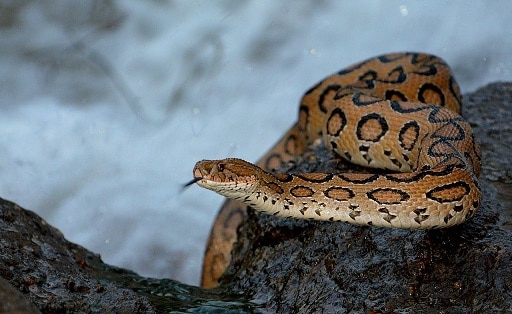
The Russell’s viper has a split personality. It takes a large amount of stimulation to rouse from them laziness, but when disturbed, they transform into a volcano of aggression.
In 2019, researchers captured 18 Russell’s vipers and surgically implanted trackers into them, before releasing them back into the Indian countryside. They noticed many things, including how one goat herder harvested leaves just 20cm away from a peacefully dozing viper, which didn’t react at all. Another tracked viper stayed put for weeks without moving, while a farmer did their “morning business” in the bushes nearby.
The researchers spoke to many farmers, and concluded that most bites happened when people stepped hard on the snake. Occasionally, the snakes didn’t react when lightly stepped on. Russell’s vipers can help farms as well, by clearing up crop-destroying pests in the form of rodents. However, one coconut farmer claimed to have killed 8 Russell’s vipers in a single morning.
Most farmers are bitten on the feet, sometimes causing their legs to be amputated. To top it off, the researchers returned from India with a dire (yet also good) conclusion: that Russell’s vipers are more common than previously thought.
| 5 | Can turn you into a child |
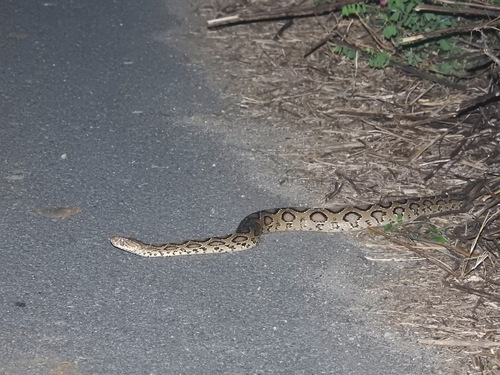
The Russell’s viper has a unique danger among snakes: pituitary gland damage. Scientists first started noticing anecdotal reports of “reverse puberty”, signs that sex hormones were being reduced and sending people’s bodies back to childhood. They proceeded to analyse 33 Russell’s viper bite survivors, in a study published by The Lancet in October 1987.
The results confirmed their worst fears, revealing reduced armpit and facial hair, evaporating sex drive, and vanishing muscle mass. Women experienced menstrual cycle problems, and close inspection reveal abnormalities in the pituitary gland, a small gland controlling various hormones. The victims never recovered, requiring hormone replacement therapy for the rest of their lives.
The precise toxin involved has never been discovered. At first, the scientists believed that only a small subpopulation of the Russell’s viper possessed this power, restricted to 4 or 5 small geographical areas. However, “reverse puberty” was later estimated to affect 29% of bite survivors. The Russell’s viper is the only snake that can send you back in time.
| 6 | Stages of evenomation |
The first stage of a Russell’s viper bite comes when you try desperately to shake the snake off your foot. Despite their sluggishness, this viper can cling to its prey to the ends of the Earth, powered by their stiff, unbending jaws.
Redness and blistering kick in after 10 minutes, and after 20 minutes, the victim’s heart rate slows and their blood pressure falls. The necrosis, AKA grisly cell death, is less severe than some species, but usually affects the entire nearby muscle. The signature danger of Russell’s viper venom is systematic bleeding caused by anticoagulant toxins. In particular, victims are known to bleed randomly from their gums and have blood-streaked urine. This deluge of blood badly intereferes with kidney function, and kidney failure is the main cause of death with this species. It happens with 20-30% of untreated bites, and other victims die from heart failure or septicaemia.
The Russell’s viper possesses a handful of neurotoxins, but its speciality is coagulants, whether pro or anti. It’s possible to perish within 1 day, but also 2 weeks later. The milder symptoms include vomiting, and one more associated with a beehive raid gone wrong: a swollen face.
| 7 | Which animals does it eat? |
One of the Russell’s viper’s specific rodent prey is the lesser bandicoot (Bandicota bengalensis), a rat which has no relation to the true bandicoots of Australia. This rat is about 25cm long on average, and the two share a fondness for farmhouses, which commonly brings them into close contact. This is one of the most aggressive rodents around, biting people viciously when they attempt to trap it.
It’s likely that this rat gives the Russell’s viper a good run for its money as well, inflicting bloody wounds which make the snake extra cautious. Unlike many snakes, the Russell’s viper prefers to bite its prey and stand well back while the venom takes effect.
In 2019, the same researchers from earlier spotted a Russell’s viper eating a palm squirrel. This Indian species is superficially similar to the grey squirrel, but has an obvious white stripe down its back. It measures 20cm from head to toe, and afterwards, the 40cm snake was so full that it was incapable of moving for 4 days.
| 8 | Who was Russell? |
Russell was the man who named the species: Patrick Russell, who was born in Edinburgh in 1727. He was the fifth son of his father’s third marriage, who travelled to the ancient city of Aleppo in 1750 (heavily bombarded in the Syrian civil war), to join his half brother Alexander. Back then, the city was often hit by outbreaks of bubonic plague, and Russell became one of the disease’s pre-eminent experts. He was a well-respected doctor, and at one point was treating 300-400 plague patients in a single afternoon. He was awarded a turban by the Pasha of Aleppo, a rarity for a European.
In 1781, he moved to India, and began a long study of the many exotic snake species there. Knowledge was so scant then that to the average Englishman, the venomous snakes of India probably felt like the stuff of mythology. One subject was his future namesake, and his many grisly experiments involved feeding dogs and chickens to the snake. Russell also became the first to describe the gruesome haemorrhagic powers of the venom.
He moved back to England in 1791 and published his great work: An Account of Indian Serpents collected on the Coast of Coromande. In 1805, he died at age 78 after a short illness. It wasn’t until 1890 that he was immortalised, as the name Vipera russelli was first written down in the book Fauna of British India.
| 9 | Random bonus facts |
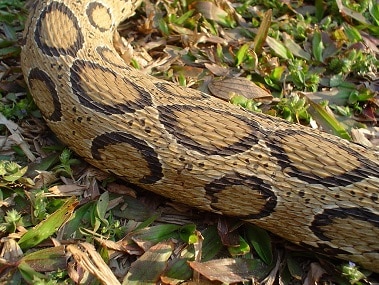
Russell’s viper venom has an LD50 score of 0.4mg, comparing respectably to the inland taipan (0.025mg), the most venomous snake in the world. The venom quantity is also generous at 150-250mg versus 1.6-8mg for the African boomslang.
The bite of a Russell’s viper is particularly efficient as well. Its fangs measure 16.5mm, and are shaped like phyodermic needles, on flexible hinges. The delivery of the bite is straight out of Hollywood. The Russell’s viper performs the classic snake manoeuvre of coiling itself into an S-shape and raising its neck back, before hissing loudly. The Russell’s viper can jump with so much force that it lifts almost its entire 1.5 metre body off the ground.
Compared to the remaining Indian big 4, the LD50 toxicity is only third, below the common krait (0.09mg) and saw-scaled viper (0.24mg), and above the Indian cobra at 0.45mg. Yet the Russell’s viper still kills the most people per year, because of the gravitation pull that farmlands have. The venom quantity is also way beyond the common krait (8-20mg), and the saw-scaled viper (5-48mg), roughly matching the Indian cobra (169-250mg).
| 10 | Baby fever |
The Russell’s viper is a nocturnal snake, except for in winter, but the cloak of nightfall is no shield. Around the world, there are many snakes with heat-sensitive pit organs that give them infrared vision at night. These snakes can detect the slightest temperature changes caused by prey species approaching. The Russell’s viper lacks these pit organs completely, but somehow has thermal-sensing powers anyway. Biologists still haven’t identified the secret replacement organ which takes up the slack, but it’s in there somewhere.
The Russell’s viper is an ovoviviparous snake, giving birth to live young after the eggs hatch inside their body. 20-40 newborns is normal, up to 70 is nothing amazing, and up to 95 is rumoured. This is one of the highest totals of any living snake.
It’s not a clean game though, as if a mother produces 70 or more neonates, then some can be born dead because of the nutrition being spread too thinly. The minimum length for a female to get pregnant is 100cm.
| !! | BONUS: family tree |
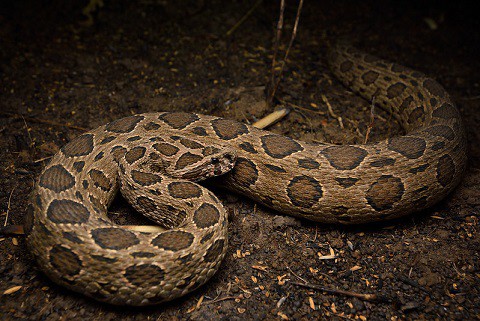
20 years ago, the Russell’s viper was the only guaranteed member of its Daboia family, but as of 2023, there’s 4 likely members. The first is the eastern Russell’s viper (Daboia siamensis), found in Thailand, Vietnam, all the way to Taiwan. This is superficially similar, but one difference is having smaller black dots between the large blotches.
The third is the Palestinian viper (Daboia palaestinae), found in Israel, the Palestinian territories and Lebanon. This has linked brown blotches, in a continuous wavy strip down its spine, and only averages at 70-90cm (the smallest member). The fourth and final member is the Moorish viper (Daboia mauritanica), found far to the west, in the sands of Morocco and Algeria. This 150cm species originally part of the Macrovipera family, but reassigned to Daboia since 2000, strengthening this small viper crew.
Outside this 4-member family, which snakes are Russell’s vipers most closely related to? There are 3900 species on Earth, and well over 300 vipers. The Afro-Eurasian land mass has endless viper types – hairy Atheris vipers, Echis sand vipers, etc. However, a 2016 analysis revealed that the true European viper family of Vipera, containing adders and alpine meadow vipers, is their closest relative. Specifically, the horned viper (Vipera ammodytes) of Greece is the Russell’s viper’s closest relative outside of its Daboia relatives.